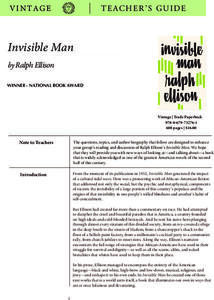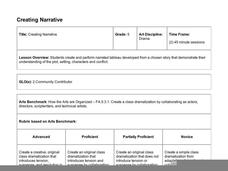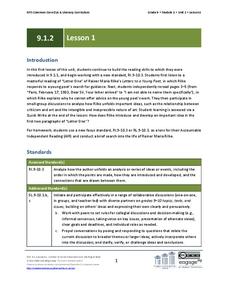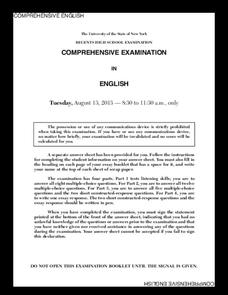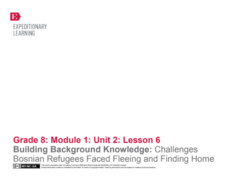Curated OER
Deconstructing Disney
Tenth graders analyze animated Disney movies. They demonstrate their awareness of how the artful use of language can affect and influence others. They evaluate how both genders and cultures are portrayed in mass media.
Curated OER
Cartoons for the Classroom: China, Tibet, and the Olympics
Political tensions have surrounded the Olympics for centuries; take a look back at the 2008 Beijing Summer Olympics with this political cartoon analysis instructional activity. Background information gives learners context regarding...
Museum of the Moving Image
Political Ads in Historical Context
Campaign ads target both timely issues and general themes. Presidential campaign ads from 1952 and 1988 provide class members an opportunity to compare how the topics ads choose to address can dramatically influence election outcomes.
National Endowment for the Humanities
Toni Morrison's Beloved: For Sixty Million and More
Complex, disturbing, and challenging, Beloved is the focus of a lesson plan that provides three activities to guide a close reading of Toni Morrison's novel. Readers create chapter titles based on key plot elements or themes,...
Penguin Books
Teacher’s Guide: Invisible Man by Ralph Ellison
Ralph Ellison's Invisible Man tops the reading list for the AP Literature exam. A five-page guide offers instructors and book clubs discussion questions designed to get readers to think deeply and critically about the inspection of...
EngageNY
Grade 9 ELA Module 2, Unit 2, Lesson 16
Was Oedipus' destiny determined by fate or by his actions? Using details from the text, ninth graders delve into a critical thinking exercise based on Sophocles' Oedipus the King. Now that Oedipus has learned his true identity, readers...
Curated OER
Justice for All
A reading of Roald Dahl’s Lamb to the Slaughter opens a discussion of justice and fairness. Using a Venn diagram and an Idea Wheel graphic organizer, class members consider the similarities and differences in these two terms. They then...
Curated OER
Excerpt from E.D. Morel's The Black Man's Burden (1920)
The included excerpt would be a perfect contrary follow-up to reading, Rudyard Kipling's White Man's Burden. Journalist E.D. Morel composed the statement against imperialism in 1920. Black Man's Burden is a wonderful primary source...
Hawaiʻi State Department of Education
Creating Narrative
Plot, setting, characters, and conflict are common to both drama and narrative stories. Kids create narrated tableaus that show their understanding of the plot, setting, and conflict of a story they've recently read. The lesson...
College Board
AP® English Language: Reading and Writing Analytically
How can teachers ensure their pupils are well prepared for the AP® English exam? The reference material is a good place to start! Educators read seven essays detailing best practices for teaching scholars to read critically and write...
New York State Education Department
Comprehensive English Examination: June 2011
Get those pencils sharpened—it's time to see what the class knows! Using the resource, scholars complete a four-part English examination. They read passages and respond to multiple-choice comprehension questions. They also complete two...
Simon & Schuster
Curriculum Guide to: Great Expectations by Charles Dickens
Great Expectations can prove to be a challenge for instructors who choose to use Dickens's novel as required reading. Here's a curriculum guide that includes lessons that address some of these challenges. The first lesson in critical...
Curated OER
Questioning Strategy for Les Miserables
After reading or watching the musical Les Miserables, challenge your high schoolers with these analysis questions. The sheet provided suggests having class members record the answers to these questions, but they would also be good...
Curated OER
Parrot in the Oven: Pre-Reading Strategy: 4 Corners
A four corners pre-reading activity introduces class members to the major themes in Victor Martinez's award winning novel, Parrot in the Oven: Mi Vida.
EngageNY
Grade 9 ELA Module 1, Unit 2, Lesson 1
Where does a writer find inspiration? "Go into yourself," says Rainer Maria Rilke in "Letter One" from Letters to a Young Poet. Readers of Rilke's letter to Franz Xaver Kappus examine the words and figurative language Rilke uses to...
Simon & Schuster
Classroom Activities for Canterbury Tales by Geoffrey Chaucer
Three lessons based on "The Wife of Bath's Prologue" from Geoffrey Chaucer's Canterbury Tales offer scholars an opportunity to examine literary satire, medieval attitudes towards women, and the form and function of a frame story.
Curated OER
The News Behind the Story
What a fun way to analyze plot, setting, and character. Learners review story elements, read a short fictional story, then turn the events of that story into a headlining news paper article. Not only does this lesson engage critical...
Curated OER
Lesson: More than Brushing my Teeth
Humor can often be found in everyday life. Young analysts critically examine a sculpture and apply what they discuss to their own life experiences. They perform skits of daily activities, such as brushing their teeth. Next, they make a...
Cloud Front
Socratic Seminar for: A Christmas Carol
Socratic seminars are a great way to encourage the development of critical thinking, speaking, and listening skills. And Charles Dickens' A Christmas Carol is a perfect text for such a seminar. Use the questions in the packet to...
Prestwick House
"Because I could not stop for Death" -- Visualizing Meaning and Tone
Emily Dickinson's "Because I could not stop for Death" provides high schoolers with an opportunity to practice their critical thinking skills. They examine the images, diction, rhythm, and rhyme scheme the poet uses and consider how...
New York State Education Department
Comprehensive English Examination: August 2013
Individuals exercise their minds by taking the Comprehensive Examination in English, which assesses listening and reading comprehension and writing aptitude. Scholars answer multiple-choice questions and write two short-response essays....
EngageNY
Grade 10 ELA Module 2: Unit 2, Lesson 6
How do authors use rhetorical devices and word choice to emphasize their ideas? Pupils consider the question while reading paragraphs 16–19 from Julia Alvarez's essay "A Genetics of Justice." Readers engage in evidence-based discussion...
EngageNY
Building Background Knowledge: Challenges Bosnian Refugees Faced Fleeing and Finding Home
What challenges did Bosnian refugees face as they fled home during the Bosnian War? Scholars read an interview with four refugees and identify common themes that connect the universal refugee experience. They also engage in a...
Penguin Books
A Teacher's Guide to the Signet Classics Edition of William Shakespeare's Henry V
Henry V is certainly not a drama "of few words." It's a sprawling study of a good yet complex king, a tumultuous time in European history, and an examination of justice and mercy. The 20-page guide to the play provides instructors...
Other popular searches
- Types of Literary Criticism
- Teaching Literary Criticism
- Literary Criticism Beloved
- 3.0 Literary Criticism
- Literary Criticism Essay
- Writing Literary Criticism
- 30 Literary Criticism
- Gender Literary Criticism






